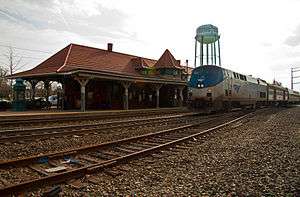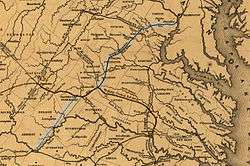Washington District
The Washington District is a Norfolk Southern Railway line in Virginia connecting Alexandria to Lynchburg. Most of the line was originally constructed during 1850–1860 by the Orange and Alexandria Railroad, with a small portion in the center opened in 1880 as the Charlottesville and Rapidan Railroad. The line is mainly used for freight service, but Amtrak's Crescent and Cardinal passenger services use all or part the line, and the Virginia Railway Express Manassas Line commuter service uses the northernmost portion of the line.

.jpg)
Route
It begins at the AF Tower in Alexandria where it splits from the CSX Transportation RF&P Subdivision. It connects to the B-Line near Manassas.[1] At Orange the Buckingham Branch Railroad's Washington Subdivision splits and forms a loop which crosses the Washington District again at Charlottesville. It crosses the CSX James River Subdivision, and then ends at Lynchburg, becoming the NS Danville District.[2]
Significant bridges along the route occur at the Rappahannock, Rapidan, South Fork Rivanna, Tye, and James Rivers. The Rivermont Tunnel is immediately adjacent to the James River crossing.[3]
History

The line was originally constructed by the Orange and Alexandria Railroad. The portion north of Orange was constructed during 1850–1854.[4][5] The extension south to Lynchburg was completed in 1860, with a short section in between that was part of the Virginia Central Railroad.[4]
After the Civil War, the company came under the control of the Baltimore and Ohio Railroad. After series of mergers, by 1881 the line was part of the Virginia Midland Railway, which in 1886 was leased to the Richmond and Danville Railroad.[4] Both were merged into the Southern Railway in 1894,[6] forming part of its main line.[3]
The Southern Railway later acquired the Charlottesville and Rapidan Railroad, which had opened in 1880,[7] bypassing the former Virginia Central Railroad segment (which is now the Buckingham Branch Railroad's Washington Subdivision). The Southern Railway merged into Norfolk Southern in 1982.[4]
Service
The line is part of Norfolk Southern's Piedmont Division. It is mainly used for freight service. As of 1999, major customers included a Pepco generating plant in Alexandria and a Cargill grain elevator in Culpeper.[3]
Amtrak's Crescent uses the entire line as part of its New York City-to-New Orleans service, and the Cardinal uses the portion from Alexandria to Orange as part of its New York City-to-Chicago service.[3]
In addition, the Virginia Railway Express Manassas Line uses the northernmost portion of the line from Alexandria to the Broad Run station just past Manassas.[8]
References
- Hawkins, David (2010). "NS Washington District North". Railfan Virginia. Retrieved 2020-08-07.
- Hawkins, David (2010). "NS Washington District South". Railfan Virginia. Retrieved 2020-08-07.
- Wilson, Paul A. (1999-01-01). "NS Piedmont Division, Washington District". Central Virginia Railfan Page. Retrieved 2020-08-07.
- "Norfolk Southern Railway History". Piedmont Railroaders. Retrieved 2020-08-09.
- Johnson, II, William Page (2004). "The Unfinished Manassas Gap Railroad" (PDF). The Fare Facs Gazette. Retrieved 2020-08-08.
- "Local History". Fairfax Station Railroad Museum. Retrieved 2020-08-08.
- Walker, Jr., Frank. "Tracks Through Time: A Railfan Tour of Orange County, Virginia". Orange County, Virginia. Retrieved 2020-08-08.
- "Virginia Railway Express Transit Development Plan" (PDF). Virginia Railway Express. 2019-02-01. p. 1-19. Retrieved 2020-08-07.